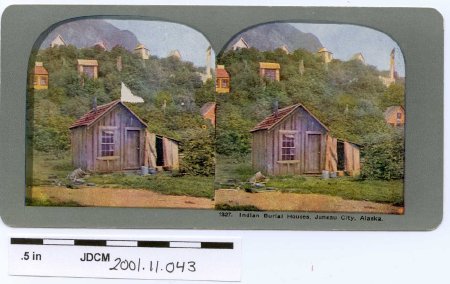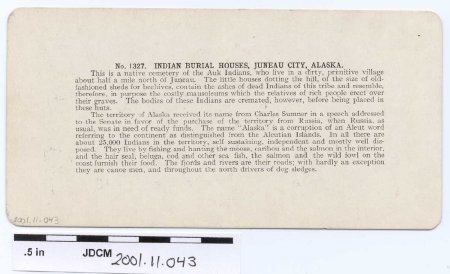Collection:
Juneau—Douglas City Museum
Object ID:
2001.11.043
Accession#:
2001.11
Credit Line:
Donated by Harold Fossum.
Object Name:
Stereoview
Title:
Stereocard, Color, Burial Houses
Date:
1910
Scope & Content:
Blue—green card with side — by — side photos of scene with group of small houses in trees. Photos are black and white, colorized with yellow, pink, brown, red and green. Both pictures depict small gray house with at least nine small houses in background. Though they are of same scene, they were taken at slightly different angles so when viewed through stereographic equipment they appear to be 3—D. Inscription under left proper photo, "1327 INDIAN BURIAL HOUSES, JUNEAU CITY, ALASKA".
Back: "NO 1327. INDIAN BURIAL HOUSES, JUNEAU CITY, ALASKA. / this is a native cemetery of the Auk Indians, who live in a dirty, primitive village / about half a mile north of Juneau. The little houses dotting the hill, are the size of old — / fashioned sheds for beehives, contain the ashes of dead Indians of this tribe and resemble, / therefore, in purpose the coastly mausaleums which the relatives of rich people erect over / their graves. The bodies of these Indians are cremated, however, before being placed in the huts. / The territory of Alaska received its name from Charles Sumner in a speech addressed / to the Senate in favor of the purchase of the territory from Russia, when Russia, as / usual, was in need of ready funds. The name "Alaska" is a corruption of an Aleut word / referring to the continent as distinguished from the Aleutian Islands. In all there are / about 25,000 Indians in the territory, self sustaining, independent and mostly well dis — / posed. They live by fishing and hunting the moose, caribou, and the salmon in the interior / and the hair seal, beluga, cod, and other sea fish, the salmon and the wild fowl on the / coast furnished their food. The fjords and rivers are their roads; with hardly an exception / as they are canoe men, and throughout the north drivers of dog sledges." Back is ivory with black print.
Material: Paper/Ink
Back: "NO 1327. INDIAN BURIAL HOUSES, JUNEAU CITY, ALASKA. / this is a native cemetery of the Auk Indians, who live in a dirty, primitive village / about half a mile north of Juneau. The little houses dotting the hill, are the size of old — / fashioned sheds for beehives, contain the ashes of dead Indians of this tribe and resemble, / therefore, in purpose the coastly mausaleums which the relatives of rich people erect over / their graves. The bodies of these Indians are cremated, however, before being placed in the huts. / The territory of Alaska received its name from Charles Sumner in a speech addressed / to the Senate in favor of the purchase of the territory from Russia, when Russia, as / usual, was in need of ready funds. The name "Alaska" is a corruption of an Aleut word / referring to the continent as distinguished from the Aleutian Islands. In all there are / about 25,000 Indians in the territory, self sustaining, independent and mostly well dis — / posed. They live by fishing and hunting the moose, caribou, and the salmon in the interior / and the hair seal, beluga, cod, and other sea fish, the salmon and the wild fowl on the / coast furnished their food. The fjords and rivers are their roads; with hardly an exception / as they are canoe men, and throughout the north drivers of dog sledges." Back is ivory with black print.
Material: Paper/Ink
Dates of Creation:
1/1/1910 0:00:00
Notes:
Collected & preserved by donor's wife, Helen Fossum.
Per Dick Wood, image taken 1892, stereo card reproduced in 1910.
Per Dick Wood, image taken 1892, stereo card reproduced in 1910.
Search Terms:
Death
Tlingit
Auk
Juneau
Architecture
Ethnographic
Tlingit
Auk
Juneau
Architecture
Ethnographic

